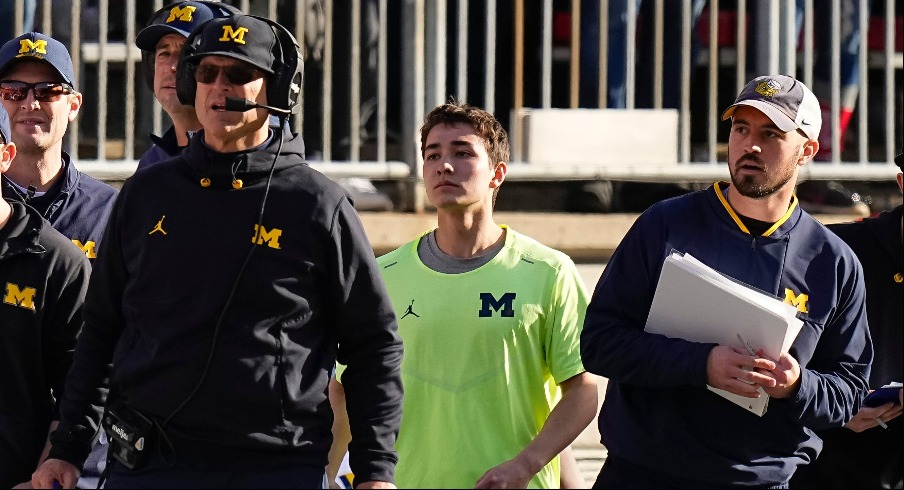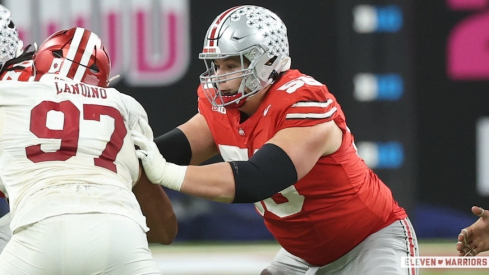Connor Stalions took another stand this week.
On Tuesday, the former Michigan football staffer appeared on the latest episode of Bussin’ With The Boys with Will Compton and Taylor Lewan. Stallions used his platform on the Barstool Sports podcast to discuss his career in Ann Arbor and the evolution of the Michigan Manifesto.
He also fired back at former Ohio State tight end Cade Stover, who recalled last month a time in 2022 when the Wolverines identified a tight end screen in a formation the Buckeyes had never used in a game.
Stalions Shares How He Started Deciphering Signals
When Compton and Lewan asked Stalions how he started deciphering signals, Stalions said a Navy football staffer assigned him the role while he was a student assistant in 2014. As luck would have it, Stalions’ first chance to decipher signals came in the Midshipmen’s 2014 season opener against Ohio State.
“It started at Navy. I asked, ‘What do I do on gameday?’ I forget who it was, but one of the coaches said, ‘Well, I don’t know. Let me look into it, but I remember last year we had a guy — he just graduated — who tried deciphering the opponent’s signals in-game,” he said. “And I knew nothing about it. I never did that in high school. I was like, ‘I don’t know. OK.’ But I went in with a blank sheet of paper, a clipboard and a pen. Our first game was Ohio State. That was the birth.
“They talked about it in the documentary, but one of my favorite quotes, I said I am one of the dumber people at the Naval Academy. I was the last person to get accepted. But I struggled (with deciphering signals). It was very, very difficult. But I’m like, ‘Well, these are 18, 19, 20-year-old kids in Columbus. If they know their signals, I can figure out their signals.’”
Stalions said it took him three drives to decipher Ohio State’s signals.
“Break that down for me a little bit,” Lewan said.
“I don’t remember exactly the plays. I think they ran Power a lot. It’s been a lot of games since then,” Stalions responded. “I just remember getting their offensive signals pretty early and not knowing what to do with the information. I would just yell it out. There wasn’t a structure. No one knew who I was. I’m two weeks into being a student coach. They don’t know who I am. The OC knew who I was, but he was up in the booth, and the director of football ops knew who I was, but that was pretty much it — and the players.
“So I’m just yelling, ‘Power left! Power left!’ And it would be Power left. … You just got to have a knack for it, but it’s not rocket science. It’s just signals.”
As the conversation continued, Stalions said he improved at deciphering signals over the years. Stalions was quick to add that he improved in other areas as well, explaining that deciphering signals was “10 to 15 percent” of his job in his final year at Michigan.
“That was one responsibility that I did,” he said. “You’re still breaking down film, getting formation tendencies, stuff like that.”
Stalions Fires Back at Cade Stover
Last month, Stover made headlines when he recalled an instance when Michigan identified that Ohio State would run a tight end screen in a formation the Buckeyes had never used in a game.
“We tried to throw a tight end screen in a formation we’ve never used before — like ever — and as soon as I lined up out wide, we had one play from it. I was going to motion back in, and they were going to throw a screen to me. And when they started yelling ‘Screen!’ when you’re throwing a tight end screen, that’s when you know like, ‘What the f— is this? We haven’t run this before,” Stover said.
Cade Stover on his rookie debut. What he brings to the table and his style. And why he didnt need to watch the Michigan sign stealing Doc, he lived it. Young man is ready to play. #HTownMade pic.twitter.com/TQ60aIXJc3
— Landry Locker (@LandryLocker) September 5, 2024
After mentioning Stover’s comments on the podcast, Compton and Lewan asked Stalions to share how Michigan knew Ohio State would run the screen. Stalions said he couldn’t remember the specific play. However, he could remember how the Buckeyes would signal their formation and plays to their offense.
“Here’s the thing: Ohio State had like eight signalers all year, something like that. Everyone signals the formation. Mistake number one. Mistake number two, they never changed who their live signaler was the entire season,” Stalions said.
“So I guess their Connor Stalions wasn’t that good then,” Lewan interrupted.
“Apparently not as good,” Stalions responded.
The producers for Bussin With The Boys then pulled up the clip of Ohio State’s failed tight end screen. Stalions’ memories of the moment flooded back to him.
“Slot Y-Y, they motioned into Slot Y-Y,” Stalions said while watching. “They signaled their signal for Slot Y-Y formation, and then the guy who was live the entire season signaled Y then delay. Am I supposed to see that and be like, ‘Oh, I don’t know what this is.’ I said, ‘This has got to be a Y-delay screen.”
Stalions Categorized Ohio State’s Offense From 2018-21
Stalions said people have given him too much credit for Michigan’s success over the years. He specifically mentioned the success Mike MacDonald and Jesse Minter have had as coordinators in college but also in the NFL.
“Mike MacDonald is a very successful college football coach and now NFL head coach. Jesse Minter, the Chargers are giving up the fewest points in the NFL right now. These guys get paid to do what they do,” he said. “They’re not like calling their defense waiting for me. I’m just a green light to tell them, ‘Hey, you have permission to signal without it getting stolen.’ That’s kind of where it picked up in ‘21, where we were no longer the mouse. It was all an even playing field essentially.”
While he acknowledged MacDonald and Minter’s success, Stalions still took some of the credit.
“I got a whole breakdown on every single play from 2018 to the present day, Michigan-Ohio State. … When Ohio State is on offense, and we’re on defense,” he said. “I watched every play on film, and I categorized it, ‘Who’s the mouse? Who’s the cat?’ And then sometimes it’s just neutral. So, in 2018, Ohio State was the cat every play. They were picking us apart signal-wise. Every time we were in Cover 1, they were running Mesh Rail. Every time we were blitzing, they happened to be in max protection and took a shot. Every time we were in zone, they ran the ball. It’s not a coincidence. I’m watching them. They have their me in Ryan Day’s ear. We signal, they talk; I see it, they talk.
“That happened in 2018 and 2019. They were the cat every play those two games. They averaged 8.15 yards per play in 2018, 8 yards per play in 2019 and they had 15 touchdowns in those two games. In 2021, it was a stalemate 72 times. They’re signaling, and then we start to signal. They were the cat three times. Here’s how I categorized them being the cat. When they had a play called, it starts off as a stalemate, and then Ryan Day gets C.J. Stroud’s attention last-second because he sees what we’re in — maybe they got our signal, maybe they see our shell, whatever it is, but they change the play right before the snap. That’s them being the cat.
“They were the mouse every time they hard counted that game. Here’s why: In 2018 and 2019, every time they hard-counted, we already had our signal called and never changed it. They exposed us. In 2021, I know their hard-count signal. I know when they’re gonna hard count. We don’t have to show a blitz or whatnot. They stole the wrong signal. We would change our call.”
Immediately, Lewan asked if Stalions knows “who Ryan Day’s Connor Stalions is.”
“Yeah, but I’m not gonna out anyone,” Stalions answered.
“As you shouldn’t, but we know he’s there.”
“Yeah.”
“Is he good at his job?”
“Yes, very.”
Stalions then jumped back to the 2021 game, explaining that Ohio State averaged 9.3 yards per play as the cat, 5.3 yards on stalemates and four yards per play as the mouse.
“In 2018 and 2019, they hard-counted 40 times. You can go back and watch the film. They hard-counted 40 times. In 2021, six, because it wasn’t working,” Stalions said. “They couldn’t steal our signal when they hard-counted because we just basically played this cat-and-mouse game with them. We didn’t allow them to be the cat every time.”


